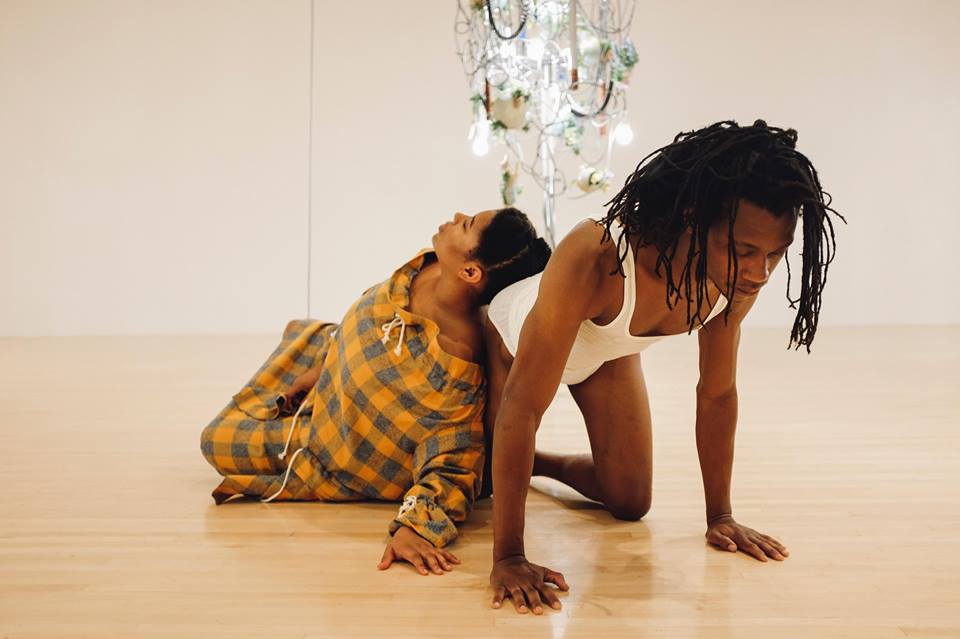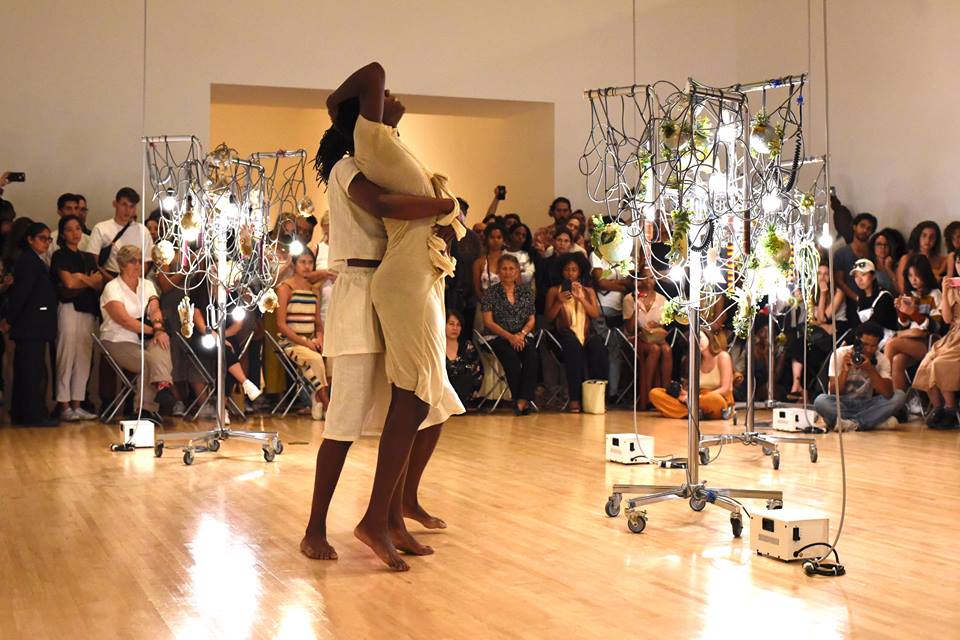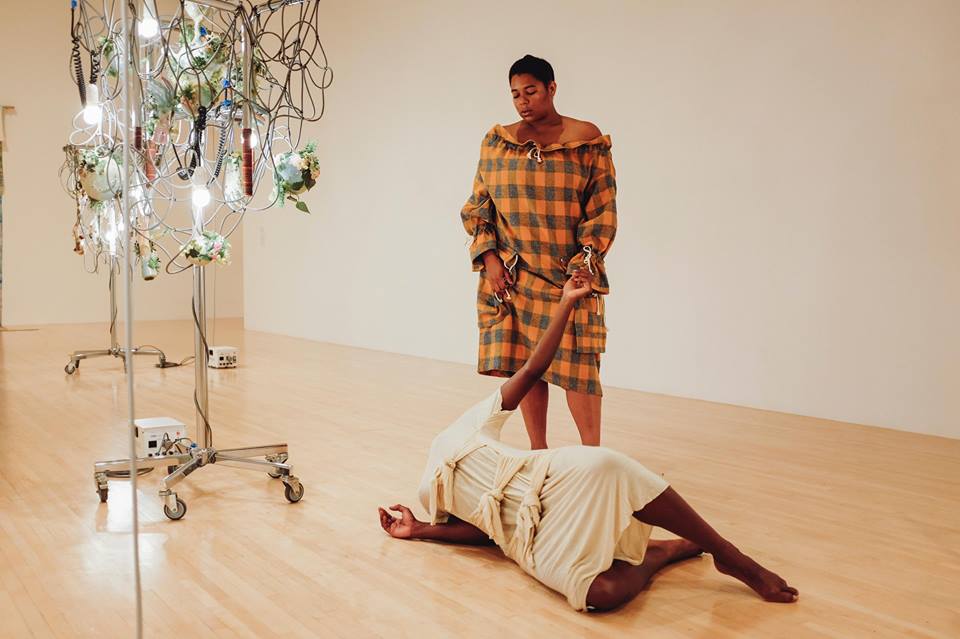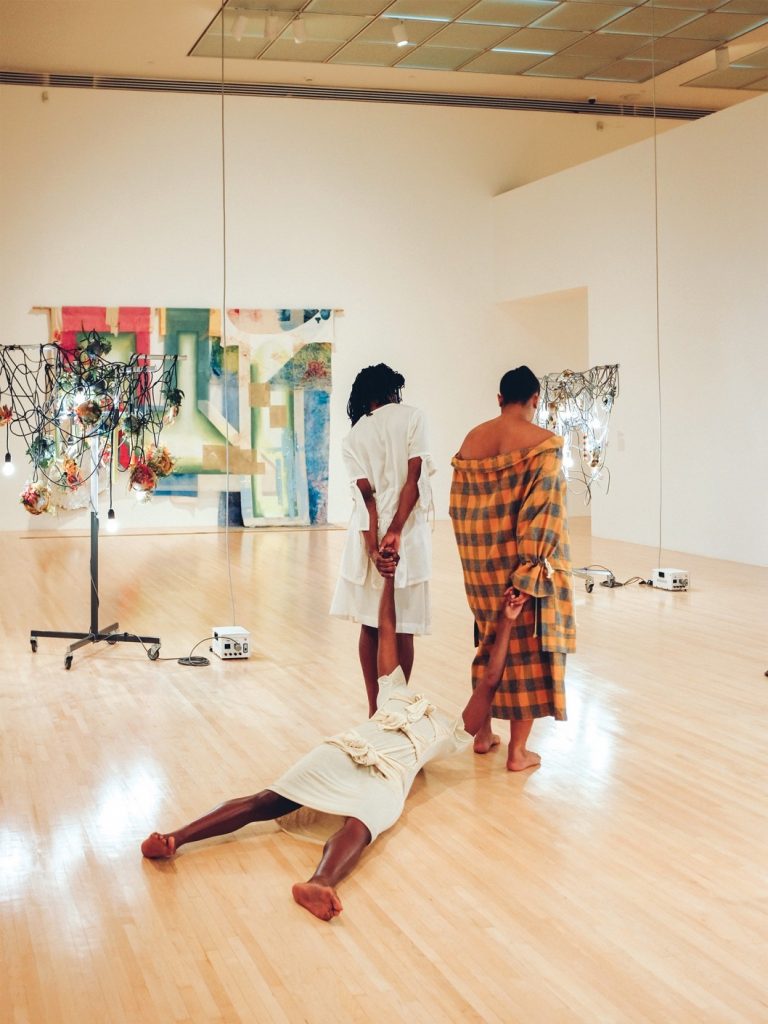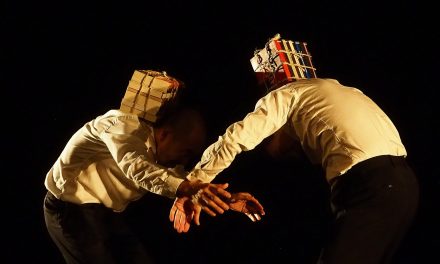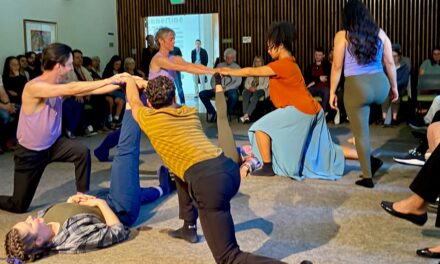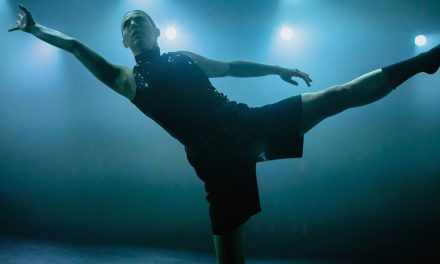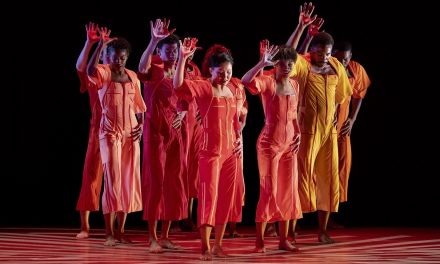Over Labor Day Weekend, No)one. Art House performed their latest piece, Fixed, at the Museum of Contemporary Art (MOCA) in downtown Los Angeles—a short 30-minute response to Haegue Yang‘s Strange Fruit (2012-13). Based on Abel Meeropol’s song of the same name (famously recorded by Billie Holiday), the art is a visual interpretation of the poem’s subject: the lynching of African Americans in the South during the 1930s. Equally poignant was the group’s dance, which would not have been as powerful if viewed on its own, but symbiotically complemented Yang’s work while evoking strong feelings about modern day violence toward Black Americans.
On Sunday, September 2, at around 3:00 in the afternoon, a small crowd gathered in the lobby of the museum to watch the three performers from No)one. Art House begin their slow trek to the wing housing Yang’s sculptures. There was no music and the costumes were simple—two of the dances, Dominique McDougal and Jessica Emmanuel, wore white, while the third, Sabrina Johnson wore a green-and-yellow checkered dress. The trio held each other’s hands and rested their heads on one another’s shoulders as they made their way down the hallway with the group of spectators following closely behind.
Yang’s six structures became visible almost immediately after crossing the first threshold into a room appropriately housing paintings by African and African diaspora artists. Among them were Lynette Yiadom-Boakye’s somber portrait of a black man titled Medicine at Playtime (2017). Images of discomfort, like Closed Contact #3 (1994-95) by other artists like Jenny Saville & Glen Luchford also created the perfect atmosphere for the dance company’s location-based show. As did the MOCA’s newest installation by Lauren Halsey: we still here, there (2018), a creatively arranged collection of trinkets from stores based in South Central Los Angeles (now called South LA). No)one. Art House’s founder and choreographer Chris Emile’s Fixed continued the theme established by these works by giving African Americans more visibility through his piece.
In the next wing, Yang’s six feet tall clothing racks wrapped in lights and curly wires ornamented with bloody hands, big eyes and other garish body parts dangling like heavy tears from poplar-styled trees awaited the performers. The “fruit” is modeled after Meeropol’s lyrics, most memorably: “The bulging eyes and the twisted mouth.” As soon as they were in sight, Emmanuel immediately turned her back away, begging to be moved in the opposite direction. Her companions gentle shoves urged her forward, though she kept her body facing away from their destination the entire time. As if adding to the melancholic movement, a baby’s cries from the audience echoed powerfully within the gallery creating a morbid soundscape to their walk. It lasted until after the dancers had reached the room and Emmanuel, the most visibly distraught of the three, had laid herself in a half-fetal position on the ground where she remained for the majority of the number. Her anti-dance move was a strong representation of the paralyzing aspect of trauma.
Most of the action took place between the other two performers, with McDougal as the stronger character. His presence was fixed and his position unyielding. Johnson heavily relied on his physicality during her character’s grieving process. Often she would lean against his shoulder, pushing him from one side of the room to the other with the top of her head. Though much of their dancing was comprised of gradual movements, her steady force would occasionally take a violent and rapid turn causing both herself and her partner to stumble backward as if suddenly shot. In those moments, his strength was not enough, either physically or emotionally, to support their weight. Throughout the dance, McDougal would typically be the first to rise, while Johnson attempted to get back on her feet by feeling for his body and using his arms and legs as climbing holds. Once she was upright again, she would cling to him as they slow-danced in solemnity.
A quiet persistence was present in Johnson’s character’s will to survive after every fall. During some of the most dramatic transitional scenes where she was unable to carry on, she would lapse into a deathly faint. In those moments, McDougal would quickly twist and twirl her torso in an attempt to revive her and keep her body from slamming into the ground. Her response would be to let her head dangle behind her, limp and unmoving until she found the stamina to start fighting again.
Short solos were performed alternatively between the two characters, each using their brief scenes to portray a different, possibly personal expression of grief and mourning. When it was Johnson’s turn, her dancing took on a different, more urgent tone, spiraling out of control by erratically spinning with arms outstretched and countenance blank. McDougal fell onto his knees during segments when he was the last man standing and there was no one left to save. He drew his hands to his face, rubbing away invisible tears before clasping them together, letting go only to swing then raise his arms directly in front of him in order to look at his palms.
Fixed reached its climax as the quickness and anger in the dancers’ movements increased, eventually leading all three, including Emmanuel, to rise up and face each other, forming a triangle around one of the installations. They spread their arms, placing them behind their head before shifting their weight from one foot to the other, gaining momentum until they began spasmodically kicking out their legs and jutting their arms forward over and over again. McDougal and Johnson slowed down shortly after initiating their part in the finale. By contrast, Emmanuel uncontrollably continued to lash out until her companions gently grabbed her arms, stopping her before she could hurt herself. The piece ended when they pulled one another in for a cathartic group hug.
Though the trees were the inspiration behind Fixed, the threesome never interacted with the pieces directly. They moved through and around them, but never spent time looking at them after arriving at the room where they were planted. This gave the rest of the dance a standalone vibe. However, there is no doubt the meaning derived from the movement would have been less powerful without the structures there to guide their emotional experience.
The presence of Yang’s art was almost more valuable to the audience who may have had an easier time contextualizing the dance than if the racks hadn’t been there, especially since viewers were able to walk around and look at the pieces up close afterward. Likewise, the company’s work brought the sculptures’ meaning to life. Though the choreography was not groundbreaking, its message was strong and had viewers later asking for repeat performances gently denied by museum staff. It functioned as a think piece that brought the past and present-day problems African Americans face in society together as one continued battle against mistreatment, showing that not enough has changed in this country’s history.
To learn more about No)one. Art House, click here.
The featured image courtesy of the artist.

